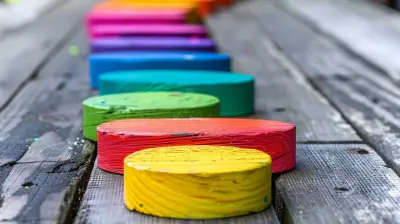5 October 2025
As educators, we often wonder: How can we inspire students to be curious? We want them to ask questions, explore new ideas, and seek knowledge beyond the classroom walls. But how exactly can assessments, which are traditionally seen as something students dread, be transformed into tools that foster curiosity?
In this article, we're going to dive deep into this topic. We'll explore methods and strategies that can turn your assessments into opportunities for students to not just show what they know—but to spark their curiosity and desire to learn more.
Ready? Let’s get started!

Why Curiosity Matters in Education
Curiosity is the driving force behind learning. Think about it for a second—when you’re curious about something, you're much more likely to dig deeper, explore, and engage with the subject. Curiosity fuels creativity, critical thinking, and problem-solving skills.Now, imagine a classroom where curiosity is the norm. Students are excited about what they're learning, they're asking thoughtful questions, and they’re eager to discover more. Sounds like a dream, right?
But here’s the kicker: curiosity doesn’t just happen. It has to be nurtured, and assessments can play a huge role in that process. Instead of being seen as a final hurdle where students just “prove” what they know, assessments can be designed as opportunities for exploration and discovery.
So, how do we do that? Let’s break it down.

The Problem with Traditional Assessments
Before we jump into the solutions, let's first address what’s not working with most traditional assessments.1. Focus on Right or Wrong Answers
Most traditional assessments—like multiple-choice tests or fill-in-the-blank quizzes—are focused on getting the "right" answer. There's little room for students to explore different possibilities or think outside the box. This kind of rigid structure doesn’t exactly scream “curiosity-friendly,” does it?2. Stress and Pressure
Assessments often come with a lot of pressure. Students are more worried about getting good grades than actually learning the material. This high-stakes atmosphere can suppress curiosity because the focus shifts from exploring ideas to simply surviving the test.3. Lack of Engagement
Let’s be honest: many traditional assessments are boring. They don’t encourage students to think critically or engage deeply with the material. Instead, they promote rote memorization—hardly a recipe for sparking curiosity.4. One-Size-Fits-All
Most assessments are designed with a “one-size-fits-all” mentality. But students aren’t all the same. They have different interests, strengths, and learning styles. By creating assessments that cater to everyone in the same way, we miss opportunities to engage students on a more personal level.
What Makes an Assessment Curiosity-Driven?
Now that we’ve covered what doesn’t work, let’s talk about what does.Curiosity-driven assessments focus on engagement, exploration, and critical thinking. They are designed to encourage students to not just answer questions but to ask their own. Here are some key elements of a curiosity-driven assessment:
1. Open-Ended Questions
Instead of having students pick from a list of pre-determined answers, give them the chance to explore. Open-ended questions allow students to approach a problem in multiple ways. They provide room for creativity and personal interpretation, which naturally fosters curiosity.For example, instead of asking, "What is the capital of France?" you could ask, "How might the history and culture of a country influence the choice of its capital city?" See the difference? The first question has only one right answer, but the second invites a deeper exploration.
2. Real-World Relevance
Students are more likely to be curious when they can see how what they're learning applies to the real world. Assessments that connect classroom material to real-world issues or scenarios can spark a student’s desire to learn more.For instance, if you're teaching a science lesson on ecosystems, you could ask students to analyze a current environmental issue and propose solutions. This not only engages their critical thinking but also ties the material to something they can see and experience in the world around them.
3. Opportunities for Reflection
Curiosity is often about self-discovery. Assessments that give students opportunities to reflect on what they've learned and how they feel about the material can be incredibly powerful. You could include reflective questions like, "What surprised you the most about this topic?" or "What do you still want to know more about?"These kinds of questions help students connect the material to their own experiences and interests, which in turn fosters curiosity.
4. Encouraging Risk-Taking
Curiosity often involves taking risks and exploring the unknown. But traditional assessments tend to discourage this by penalizing mistakes. Instead, consider creating assessments that reward risk-taking and creative thinking.For example, you could offer extra credit for students who come up with an original approach to solving a problem, even if their solution isn't perfect. Or, you could allow students to revise their work after receiving feedback, encouraging them to take risks without the fear of failure.
5. Scaffolded Exploration
Sometimes, students need a little guidance before they can start exploring on their own. Scaffolding is a teaching technique that provides support at the beginning and gradually removes it as students become more confident.In assessments, this could look like providing guiding questions or prompts that help students get started, but then allowing them to take the reins and explore in their own way. Over time, they’ll build the skills and confidence to tackle more open-ended, curiosity-driven tasks.

Strategies for Creating Curiosity-Driven Assessments
Now that we know what curiosity-driven assessments look like, let’s get into some practical strategies you can use to create them.1. Use Project-Based Assessments
One of the best ways to foster curiosity is through project-based assessments. Instead of a traditional test, students work on a project that allows them to explore a topic in depth. This could be anything from creating a presentation, developing a model, or writing a research paper.The key here is to give students some choice in what they explore. For example, if you're teaching a unit on history, you could let students choose a historical figure or event to research and present. This gives them autonomy and allows them to follow their own interests, which is a huge driver of curiosity.
2. Incorporate Inquiry-Based Learning
Inquiry-based learning is all about asking questions. In this approach, students are encouraged to develop their own questions about a topic and then investigate the answers. This method turns the traditional assessment model on its head—rather than the teacher asking the questions, the students do!For example, instead of giving students a list of questions to answer after reading a text, you could ask them to generate their own questions and then choose one to investigate further. This encourages them to think critically and follow their curiosity.
3. Gamify Assessments
Who doesn’t love a good game? Gamifying assessments can make the process more engaging and fun, which naturally sparks curiosity. You could create quizzes that resemble trivia games, design escape-room-style challenges, or offer badges and rewards for completing certain tasks.For example, you could create a scavenger hunt where students have to solve riddles or complete challenges related to the material they’re learning. This makes the assessment feel more like a game than a test, which can help lower stress and encourage exploration.
4. Encourage Collaborative Learning
Collaboration is a fantastic way to spark curiosity. When students work together, they share different perspectives and ideas, which can lead to new questions and discoveries.Incorporating group projects or collaborative assessments can encourage students to learn from each other. For instance, you could assign a group research project where each student is responsible for exploring a different aspect of a broader topic. When they come together to share their findings, they’ll likely be curious about what their peers have discovered.
5. Incorporate Technology
Technology offers endless opportunities to create curiosity-driven assessments. Tools like virtual simulations, interactive websites, or even social media can allow students to explore topics in new and exciting ways.For example, you could use virtual field trips to take students to places they wouldn’t be able to visit in person, like a distant country or a historical site. Or, you could create an online discussion forum where students can ask questions and share resources related to the material they’re studying.
Conclusion: Assessments Are Opportunities for Exploration
At the end of the day, assessments don’t have to be something students dread. When designed thoughtfully, they can be powerful tools for fostering curiosity and a lifelong love of learning.By incorporating open-ended questions, real-world relevance, opportunities for reflection, and a little bit of risk-taking, you can transform your assessments into something that not only measures what students know but also encourages them to want to learn more.
Remember, curiosity is contagious. Once students catch it, there’s no stopping them!








Zain McGillivray
This article offers valuable insights into designing assessments that nurture curiosity in students. By emphasizing open-ended questions and real-world applications, educators can encourage deeper thinking and engagement. Balancing structure with flexibility is key to fostering an environment where students feel free to explore and inquire. Great read!
November 8, 2025 at 4:14 AM